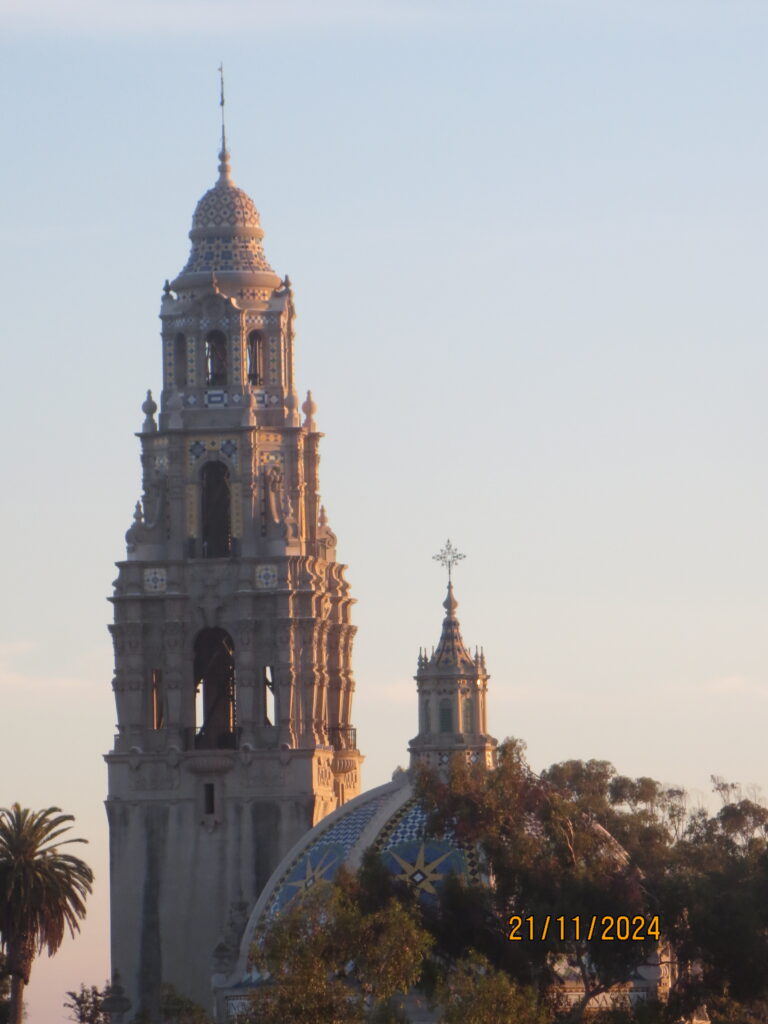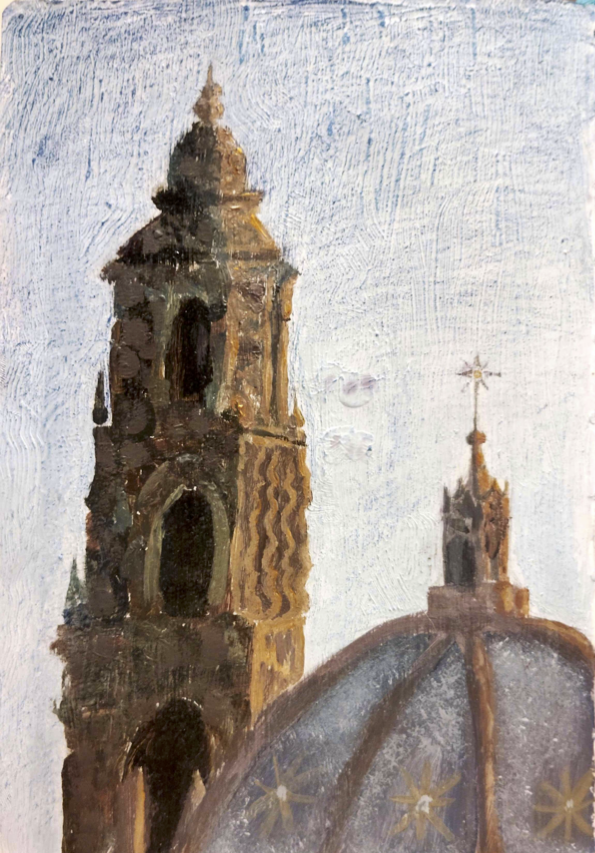The San Diego Zoo Skyfari tram swung haphazardly 90 feet in the air, throwing me, three friends and my Canon digital camera off balance. Six hands stabilized my shoulders and the extended lens, which was zoomed to its fullest extent to capture the grandiose Balboa Tower, 10 stories and 200 feet high, bathed in amber sunlight a mile away from our midair tram in the San Diego Zoo.
Less than a week later, I stood watching the trams pass by from the weathered balcony, 100 feet up on the picturesque tower I photographed.
This new lofty view of Balboa Park gave me a cardio workout, a newfound appreciation for the park and inspiration for a quick acrylic-tempera painting.
While waiting for the tour, my mom and I explored the Museum of Us at the base of the tower. One exhibit reminded me of the PLNU Border Pilgrimage trip I recently went on (the subject of Art in Transit Vol. 1).
My mom and I stood gazing up at thousands of handwritten yellow and white toe tags pinned to a large map of the Sonoran Desert of Arizona, a perilous, desolate land around the U.S.-Mexico border. After the 1994 U.S. “Prevention Through Deterrence” policy limited undocumented migrant crossing at urban entry areas, migrants flocked to remote areas in order to cross, such as this desert. More than six million people have gathered to make the dangerous journey, and over 3,200 have died, represented by the toe tags.
We read names, dates, ages and locations on the tags. The cause of death and body condition were also on the tags.
I turned over one tag among the thick heaps of hanging cards closest to the border. Ulises Martinez Garcia, male, 16 years old and so close.
Imagining this teenage boy, hiking through the sand and heat with strength and hope, put a human face to the numbers many Americans see and ignore every day. Hostile Terrain 94 was a striking visual of the policy’s deadly consequences for so many more like young Ulises.
After reflecting on the exhibit and Border Pilgrimage, it was time to climb. Our tour group gathered, and started up the narrow staircases. Donors’ names glowed in white light on each illuminated step, and I noticed one in a unique language. The tour guide informed me that it was written in Elvish, the language from the “Lord of the Rings” franchise.
UC Irvine Anthropology graduate Carley Hall, who has worked for the Museum of Us for about five months, led the tour, sharing facts about the founding of Balboa Park and other San Diego Landmarks on each level.
First, Hall talked us through the ground exposition plan of Balboa Park. Originally named City Park, it was built in 1915 to celebrate and host the opening of the Panama-California Exposition, a world fair.
The event promoted San Diego as a main port on the new Panama canal, and to welcome sailors from different parts of the world, separate areas of the park put native cultures on display.
However, the exhibits were questionable in their accurate and respectful portrayals of different cultures. Chinatown, for instance, included crude depictions of Chinese opium dens, and wasn’t even open to Chinese people.
Climbing to the next level of the tower, Hall shared the story of Hotel Douglas, a 1920s black nightclub and hotel named after Frederick Douglas that used to be in Gaslamp Quarter in Downtown San Diego. The place was visited by huge musicians like Billie Holiday and Duke Ellington. A small plaque marks the spot of this historical nightclub at the intersection of Market and 2nd Street downtown.
The rickety, spiral staircase led us to the balcony area of the tower, and some mythbusters from Hall.
The tower, though designed after Spanish religious architecture, was never a church – a common misconception.
In addition, the bell tower has no bells. Instead a carillon creates the bell-like sounds that ring across the park every day on schedule. The instrument is played with a keyboard controlling small chimes, and amplified on speakers at the top of the tower. Visitors could write song suggestions of the carillon playlist, where I wrote “Please, Please, Please” by Sabrina Carpenter.
Although the tenth story was only for city employees, the view from halfway up was exhilarating. The park looked so miniature in comparison to its importance in San Diego history as a port city. Chilly winds swirled around the solid structure, blowing my hair off my neck as I touched the carved, smooth walls I’d traced a few days ago.


My fingers first found divots and curves in the massive rock, and next a paintbrush, ready to capture the experience of the tour.
For California residents with ID, The Museum of Us has free entry every fourth Tuesday of the month excluding December. General admission costs $16.95 for students, teachers, seniors, military and youth any other time.
To book, visit California Tower Tour Reservations at Museumofus.org.
